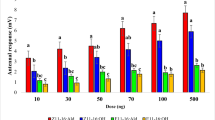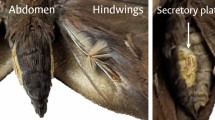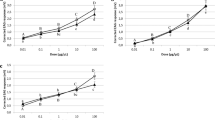Abstract
The mahogany shoot borer, Hypsipyla grandella, is one of the most economically important Neotropical forest pest insects because it attacks valuable timber of the Meliaceae. Despite detailed information on the life cycle of H. grandella, factors influencing attack by the shoot borer are not well known. Electroantennogram studies of borer antennae indicate that both female and male moths elicited significant antennal responses to essential oil of the terminal shoots, mature and senescent leaves, in three concentrations. γ-Himachalene, germacrene D, germacrene A, cadina-1,4-diene, hexadecanoic acid, and ethyl hexadecanoate appeared in all essential oils from Swietenia macrophylla. Germacrene-D and γ-himachalene were also present in the active essential oil of Cedrela odorata and Toona ciliata. These findings suggest that these compounds play a role in attracting H. grandella to oviposit on the leaves of these plants. The GC-EAD of essential oil from S. macrophylla mature leaves to female H. grandella antennae led to the identification of β-caryophyllene as the main constituent responsible for the antennae response.
Similar content being viewed by others
References
Adams, R. P. 1995. Identification of Essential Oil Components by Gas Chromatography Mass Spectroscopy. Allures Publishing, New York.
Bjostad, L. B. 1998. Electrophysiological methods, pp. 339–369, in K. F. Haynes and J. G. Millar (Eds.). Methods in Chemical Ecology: Chemical Methods, Vol. 1, Chapman and Hall, London.
Dool, H. Van Den and Kratz, P. D. 1963. A generalization of the retention index system including linear temperature programmed gas-liquid partition chromatography J. Chromatogr..11:463–471.
Grijpma, P. 1973. Studies on the shootborer Hypsipyla grandella (Zeller) Lep. Pyralidae. Vol. I, IICA. CATIE, Turrialba, Costa Rica. (Miscellaneous Publications No. 101).
Grijpma, P. and Gara, R. I. 1970. Studies on the shootborer Hypsipyla grandella (Zeller). Host selection behaviour. Turrialba 20:233–240.
Grijpma, P. and Ramalho, R. 1969. Toona spp., posibles alternativas para el problema del barrenador Hypsipyla grandella de las Meliaceae en América Latina, in P. Grijpma (ed.). Studies on the shootborer Hypsipyla grandella (Zeller) Lep. Pyralidae. Turrialba 19:531–547.
Maia, B. H. L. N. S., DE Paula, J. R., Sant'ana, J., da silva, M. F. das G. F. Fernandes, J. B., Vieira, P. C., Costa, M., do S. S. Ohashi, O. S., and Silva, J. N. M. 2000. Essential Oils of Toona and Cedrela Species (Meliaceae): Taxonomic and Ecological Implications. J. Braz. Chem. Soc. 11:629–639.
Newton, A. C., Baker, P., Ramnarine, S., Mesén, J. F., and Leakey, R. R. B. 1993. The mahogany shoot borer: Prospects for control. Forest Ecol. Manag. 57:301–328.
Parra, J. R. P. 1986. Criação de insetos para estudos com patógenos, pp. 348–373, in S. B. Alves (ed.). Controle Microbiano de Insetos. Manole, São Paulo, Brazil.
Sanchez, J. C., Holsten, E. H., and Whitmore, J. L. 1976. Comportamiento de 5 espécies de Meliaceae en florencia Sur, Turrialba, pp. 97–103, in Whitmore, J. I. (ed.). Studies on the Shootborer Hypsipyla grandella (Zeller) Lep. Pyralidae. Vol. III, IICA. CATIE, Turrialba, Costa Rica. (Miscellaneous Publications No. 101).
Schabel, H., Hilje, L., Nair, K. S. S., and Varma, R. V. 1999. Economic entomology in tropical forest plantations: An update. J. Trop. For. Sci. 11:303–315.
Speight, M. R. 1997. Forest pests in the tropics: Current status and future threats, pp. 207–227, in A. D. Watt, N. E. Stork, and M. D. Hunter (Eds.). Forest and Insects. Chapman & Hall, London.
Whitmore, J. L. 1976. Studies on the Shootborer Hypsipyla grandella (Zeller) Lep. Pyralidae. Vol. II, IICA. CATIE, Turrialba, Costa Rica. (Miscellaneous Publications No. 101).
Zeller, P. C. 1848. Exotische Phyciden. Isis van Oken. 41:857–890.
Author information
Authors and Affiliations
Corresponding author
Rights and permissions
About this article
Cite this article
Soares, M.G., Batista-Pereira, L.G., Fernandes, J.B. et al. Electrophysiological Responses of Female and Male Hypsipyla grandella (Zeller) to Swietenia macrophylla Essential Oils. J Chem Ecol 29, 2143–2151 (2003). https://doi.org/10.1023/A:1025694720727
Issue Date:
DOI: https://doi.org/10.1023/A:1025694720727




